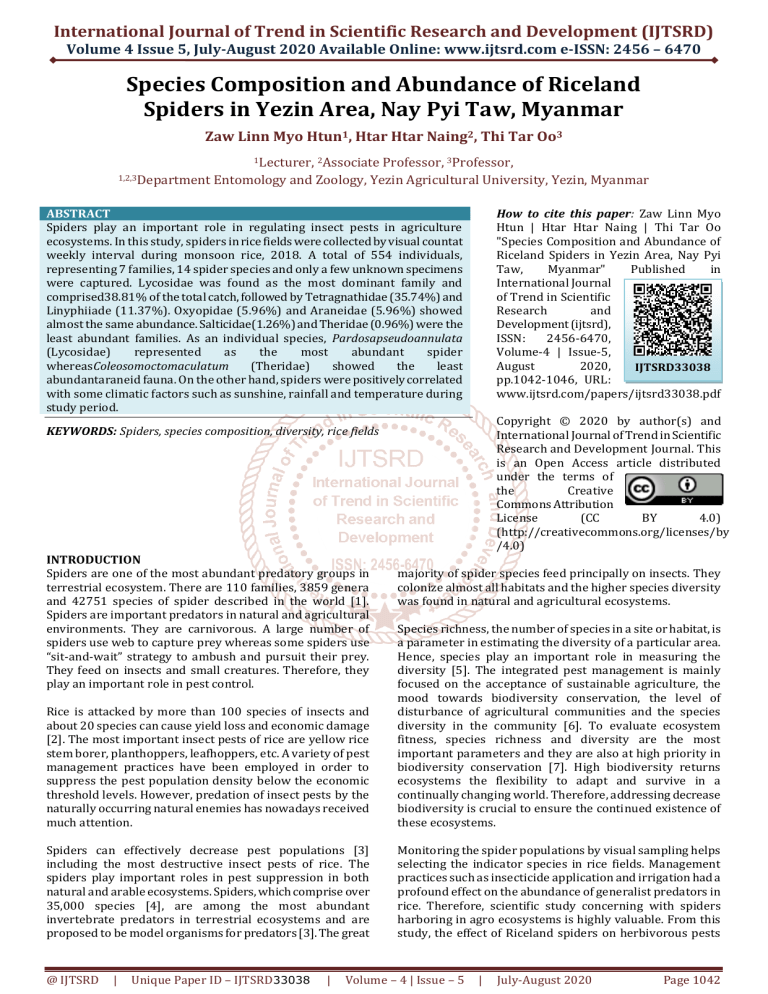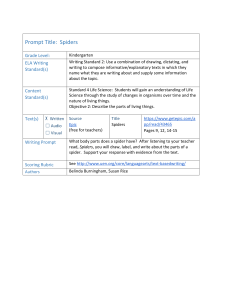
International Journal of Trend in Scientific Research and Development (IJTSRD)
Volume 4 Issue 5, July-August 2020 Available Online: www.ijtsrd.com e-ISSN: 2456 – 6470
Species Composition and Abundance of Riceland
Spiders in Yezin Area, Nay Pyi Taw, Myanmar
Zaw Linn Myo Htun1, Htar Htar Naing2, Thi Tar Oo3
1Lecturer, 2Associate
Professor, 3Professor,
1,2,3Department Entomology and Zoology, Yezin Agricultural University, Yezin, Myanmar
ABSTRACT
Spiders play an important role in regulating insect pests in agriculture
ecosystems. In this study, spiders in rice fields were collected by visual countat
weekly interval during monsoon rice, 2018. A total of 554 individuals,
representing 7 families, 14 spider species and only a few unknown specimens
were captured. Lycosidae was found as the most dominant family and
comprised38.81% of the total catch, followed by Tetragnathidae (35.74%) and
Linyphiiade (11.37%). Oxyopidae (5.96%) and Araneidae (5.96%) showed
almost the same abundance. Salticidae(1.26%) and Theridae (0.96%) were the
least abundant families. As an individual species, Pardosapseudoannulata
(Lycosidae)
represented
as
the
most
abundant
spider
whereasColeosomoctomaculatum
(Theridae)
showed
the
least
abundantaraneid fauna. On the other hand, spiders were positively correlated
with some climatic factors such as sunshine, rainfall and temperature during
study period.
How to cite this paper: Zaw Linn Myo
Htun | Htar Htar Naing | Thi Tar Oo
"Species Composition and Abundance of
Riceland Spiders in Yezin Area, Nay Pyi
Taw,
Myanmar"
Published
in
International Journal
of Trend in Scientific
Research
and
Development (ijtsrd),
ISSN:
2456-6470,
Volume-4 | Issue-5,
August
2020,
IJTSRD33038
pp.1042-1046, URL:
www.ijtsrd.com/papers/ijtsrd33038.pdf
Copyright © 2020 by author(s) and
International Journal of Trend in Scientific
Research and Development Journal. This
is an Open Access article distributed
under the terms of
the
Creative
Commons Attribution
License
(CC
BY
4.0)
(http://creativecommons.org/licenses/by
/4.0)
KEYWORDS: Spiders, species composition, diversity, rice fields
INTRODUCTION
Spiders are one of the most abundant predatory groups in
terrestrial ecosystem. There are 110 families, 3859 genera
and 42751 species of spider described in the world [1].
Spiders are important predators in natural and agricultural
environments. They are carnivorous. A large number of
spiders use web to capture prey whereas some spiders use
“sit-and-wait” strategy to ambush and pursuit their prey.
They feed on insects and small creatures. Therefore, they
play an important role in pest control.
majority of spider species feed principally on insects. They
colonize almost all habitats and the higher species diversity
was found in natural and agricultural ecosystems.
Rice is attacked by more than 100 species of insects and
about 20 species can cause yield loss and economic damage
[2]. The most important insect pests of rice are yellow rice
stem borer, planthoppers, leafhoppers, etc. A variety of pest
management practices have been employed in order to
suppress the pest population density below the economic
threshold levels. However, predation of insect pests by the
naturally occurring natural enemies has nowadays received
much attention.
Species richness, the number of species in a site or habitat, is
a parameter in estimating the diversity of a particular area.
Hence, species play an important role in measuring the
diversity [5]. The integrated pest management is mainly
focused on the acceptance of sustainable agriculture, the
mood towards biodiversity conservation, the level of
disturbance of agricultural communities and the species
diversity in the community [6]. To evaluate ecosystem
fitness, species richness and diversity are the most
important parameters and they are also at high priority in
biodiversity conservation [7]. High biodiversity returns
ecosystems the flexibility to adapt and survive in a
continually changing world. Therefore, addressing decrease
biodiversity is crucial to ensure the continued existence of
these ecosystems.
Spiders can effectively decrease pest populations [3]
including the most destructive insect pests of rice. The
spiders play important roles in pest suppression in both
natural and arable ecosystems. Spiders, which comprise over
35,000 species [4], are among the most abundant
invertebrate predators in terrestrial ecosystems and are
proposed to be model organisms for predators [3]. The great
Monitoring the spider populations by visual sampling helps
selecting the indicator species in rice fields. Management
practices such as insecticide application and irrigation had a
profound effect on the abundance of generalist predators in
rice. Therefore, scientific study concerning with spiders
harboring in agro ecosystems is highly valuable. From this
study, the effect of Riceland spiders on herbivorous pests
@ IJTSRD
|
Unique Paper ID – IJTSRD33038
|
Volume – 4 | Issue – 5
|
July-August 2020
Page 1042
International Journal of Trend in Scientific Research and Development (IJTSRD) @ www.ijtsrd.com eISSN: 2456-6470
and the changes of climatic factors on spider colonization
can be observed [8]. In Myanmar, however, there is a dearth
of information concerning with Riceland’s spiders. The
present study is therefore aimed at documenting the species
composition of spiders in rice fields in Yezin area, Nay Pyi
Taw, Myanmar.
MATERIALS AND METHODS
Experimental Site
The experiment was carried out in the fields near Yezin
Agricultural University and Kantharaye village located in
Nay Pyi Taw, Myanmar. It is located at 19.8409N and
96.2633E. The altitude is about 114 m. The temperature
ranged from 21°C to 42°C, the relative humidity 78% - 95%,
rainfall from 0 mm to 14 mm and sunshine 2.93 hour to 6.93
hour, respectively during the study period. The study was
conducted during the monsoon rice season (August –
October), 2018.
Experimental protocol
Spiders in the rice fields were collected at weekly interval
from one week after transplanting rice seedlings to one week
before harvest. Two experimental sites, one acre in each
location, were selected for collecting spiders by visual count.
In each location, two 0.5 acre fields were selected for data
collection. Subsequently, five sampling plots, one square
meter each, were subdivided as sampling site within each
0.5-acre field. There were 24 hills within each sampling plot.
Spiders were collected from those sampling plots. All
collected spiders species were kept in a mixed solution of
75% ethanol + 5% glycerine + 5% glacial acetic acid for
further identification.
Because of the difficulty of identifying juvenile spiders, only
adult stages were identified in the laboratory of Department
of Entomology and Zoology, Yezin Agricultural University
using the keys presented by [9].
Data Analysis
Index of Species Diversity: Abundance and species richness
of insect species in monsoon rice production was measured
by the Shannon-Wiener function [10]. Shannon Wiener
function was used to measure the index of species diversity
by the following formula:
s
H = - Σ (Pi) (log2Pi)
i=1
Where;
H = index of species diversity or information content of
sample (bits/individual)
s = number of species
pi = proportion of total sample belonging to ith species
Equitability (evenness) can be measured by the following
formula;
E = H / H max
Where;
E = equitability (range 0 – 1)
H = observed species diversity
H max = maximum species diversity = log2S
Shannon-Wiener function was analyzed in Excel 2010 and
the rest of the data were analyzed using JMP (Version 10).
The data were firstly tested for homogeneity of variances
(Bartlett’s test, P > 0.05). If homogeneity of variances were
not met by any transformations, non-parametric tests were
used. Total individuals captured in each month were
analyzed by one-way ANOVA.
RESULTS AND DISCUSSION
Species diversity and richness of spiders in monsoon
rice of Yezinarea
The index of spider species diversity and equitability in
monsoon rice at Yezin area were estimated by using ShanonWiener function.
For the visual count in two locations of monsoon rice, 14
spider species belong to 7 families and only a few unknown
specimens were collected (Table 1). The total number of
spiders found in all experimental sites during monsoon
season under visual count was 554 individuals (excluding
unknown species) in which Pardosapseudoannulata
(Boesenberg and Strand) was found in the highest number in
the rice fields of YAU whereas Tetragnathidae showed more
abundant in that of Kantharaye village.
Table 1 Average number of spiders collected during the study period.
Average spider per week
No. Spider Families Spider species in rice fields
Yezin
Kantharaye
1
Lycosidae
1. Pardosapseudoannulata
20.50
15.33
8.33
11.67
1. Tetragnathamaxillosa
2
Tetragnathidae
2. Tetragnatha nitens
0.50
0.67
3. Leucaugefastigata
5.50
6.33
0.17
0.17
1. Coleosom octomaculatum
3
Theridiidae
2. Chrysso sp.
0.33
0.17
0.50
0.83
1. Singa sp.
4
Araneidae
2. Argiopebruennichii
0.50
1.50
3. Argiopecatenulata
0.67
1.50
3.33
2.83
1. Erigonidiumgraminicola
5
Linyphiidae
2. Atypenaformosana
1.67
2.67
6
Salticidae
1. Myrmarachneassimilis
0.50
0.67
1.50
1.83
1. Oxyopesjavanus
7
Oxyopidae
2. Oxyopeslineatipes
0.83
1.33
@ IJTSRD
|
Unique Paper ID – IJTSRD33038
|
Volume – 4 | Issue – 5
|
July-August 2020
Page 1043
International Journal of Trend in Scientific Research and Development (IJTSRD) @ www.ijtsrd.com eISSN: 2456-6470
Pardosapseudoanulata (Lycosidae) were the most abundantaraneid fauna gathered from the whole period of study in rice
paddies of Yezin area. The population of ground dwelling spiders peaked in the June and were dominated by Lycosidae [12].
The similar studies in temperate zone demonstrated that the Lycosids accounted for 43% of the cursorial species [13].
The abundance of spider families was depicted in Figure (1). Family Lycosidae constituted up to 38.81% followed by
Tetragnathidae (35.74%) and Linyphiiade (11.37%), Oxyopidae (5.96%), Araneidae (5.96%), Salticidae (1.26%) and Theridae
(0.90%) in descending order. Reference [14] reported the similar results in which Lycosidae is one of the most abundant
families of ground dwelling hunting spiders. The possible reason for their high abundance in the collection might be their active
foraging behavior and high adaptation in wetland environment.
Figure 1 Relative abundance of spider families during the study period
No.
1
2
3
4
5
6
7
8
9
10
11
12
13
14
Table 2 Diversity and equitability derived from the Shannon-Wiener function
Spider species in rice paddies of Yezin Area Proportional abundance (pi) -(pi) (log2pi)
Pardosapseudoannulata
0.066787
0.001343
Tetragnathamaxillosa (Thorell)
0.046931
0.000663
Leucaugefastigata (Simon)
0.036101
0.000392
Tetragnathanitens (Audouin)
0.023466
0.000166
Coleosomoctomaculatum
0.388087
0.045334
Chrysso sp.
0.216606
0.014122
Singa sp.
0.128159
0.004944
Argiopebruennichii (Scopoli)
0.012635
4.81E-05
Argiopecatenulata (Doleschall)
0.00361
3.92E-06
Erigonidiumgraminicola (Sundevall)
0.005415
8.83E-06
Atypenaformosana (Oi)
0.012635
4.81E-05
Myrmarachneassimilis Banks
0.021661
0.000141
OxyopesjavanusThorell
0.023466
0.000166
Oxyopeslineatipes (C.L. Koch)
0.01444
6.28E-05
Index of species diversity, H =
0.07
Hmax = Log2S = Log2 (14) = Log14/Log2
3.81
Equitability = E = H/Hmax
0.02
The index of species diversity (H) of spider during study period is 0.07 and evenness of species (E) is 0.02 (Table 2). The
equitability value (E), 0.02indicates that there is single species dominance and the spider species were not equally abundant in
study area. Spider abundance is directly related to habitat complexity and kinds of vegetation [9]. The higher the numbers of
spiders were observed as the rice plants increase its complexity with time.
Spider species richness
Of the adult individuals, 14morphospecies were determined during the study period in both locations (Table 1). There was a
significant difference between the catch of spider species and month of catch(p = 0.0067). In our results, only 9 species were
captured in August (Figure 2), the more spider species was obtained in the catch of September, followed by that of October
(Figure 2). According to figures, more lycosids were captured at YAU fields while more tetragnathids obtained from that of
Kantharaye village throughout the survey period except August.
According to figure (2), the most abundant araneid was wolf spider Pardosapseudoannulata (Lycosidae) that was observed in
every week and the least abundant species was Coleosomoctomaculatum (Araneidae). In August, the more P. pseudoannulata
@ IJTSRD
|
Unique Paper ID – IJTSRD33038
|
Volume – 4 | Issue – 5
|
July-August 2020
Page 1044
International Journal of Trend in Scientific Research and Development (IJTSRD) @ www.ijtsrd.com eISSN: 2456-6470
(Lycosidae) was obtained from Kantharaye fields compared to that of YAU’s. However, in catch of September and October, P.
pseudoannulata (Lycosidae) showed more abundant species at YAU fields, followed by T. maxillosa (Tetragnathidae). Only
those two spider families represented at higher percentage throughout the study period compared to other families.
Figure.2 Abundance of the spider species in rice fields of Yezin area duringstudy period (August – October)
The variation in colonization of spider species in rice fields might depend on their foraging strategies and prey they consume.
For example, web-building spiders rely almost exclusively on insects as their prey; cursorial hunting spiders additionally
capture and eat other prey including even their conspecifics into their diet [15]. However, cursorial spiders also differ strongly
in their foraging mode, as some employ a sit-and-wait strategy (Thomisidae), while others actively hunt down their prey
(Salticidae) [3]. Wolf spiders are visually orienting predators, which can detect their prey by movement and vibrations ranging
from sit-and-wait strategy (Hognasp) to more active predators that hunt down their prey (Pardosasp). As major prey group of
wolf spider diets includes Diptera, Hemiptera, Collembola, and Araneae [16], Lycocid family can occupy the rice fields whether
the insect pest is present or not.
Species composition of spiders in relation to some climatic factors
It was observed that spider numbers and some climatic factors such as temperature and rainfall within respective range were
positively correlated. However there was a negative correlation between number of spiders captured and relative humidity.
Almost no correlation was observed spider numbers and sunshine. According to results, it was clearly demonstrated that
increase in rainfall (0 – 14 mm) and temperature (29.5°C– 34.5°C) favored increasing spider population to some extent. During
the study period, most of the time was cloudy condition and as a result, a few species of spider were captured. In this study,
increase in rainfall (0 – 14 mm) in favored the increase of spider population, however, rainfall over 190 mm suppressed the
spider population [17]. There was a scarcity of rain during our study although the RH was comparatively high.
Regression Plot
Regression Plot
225
225
200
Y = -17.339 + 9.373 * X; R^2 = .332
175
175
150
150
Spider Numbers
Spider numbers
200
125
100
75
50
100
75
50
25
0
0
-25
0
@ IJTSRD
125
25
-25
|
Y = 840.417 - 9.213 * X; R^2 = .469
2
4
6
8
Rainfall (mm)
10
Unique Paper ID – IJTSRD33038
12
|
14
76
78
Volume – 4 | Issue – 5
80
|
82
84
86
88
RH (%)
July-August 2020
90
92
94
96
Page 1045
International Journal of Trend in Scientific Research and Development (IJTSRD) @ www.ijtsrd.com eISSN: 2456-6470
Regression Plot
Regression Plot
225
225
200
Y = -554.352 + 18.315 * X; R^2 = .11
175
175
150
150
Spider Numbers
Spider Numbers
200
125
100
75
50
125
100
75
50
25
25
0
0
-25
29.5
Y = 16.376 + 4.882 * X; R^2 = .009
-25
30
30.5 31
31.5 32 32.5
Temperature (C)
33
33.5
34
34.5
2.5
3
3.5
4
4.5
5
Sunshine (hr)
5.5
6
6.5
Figure 3 Relationship between spider numbers and (a) rainfall (mm), (b) relative humidity (%), (c) temperature
(°C), (d) sunshine (hr) through August to October 2018 in monsoon rice of Yezin area.
Regardless of fairly high temperature through August to October, the spider population kept increased (Figure 3). That result
might be temperature has no effect on spiders during this range. However extreme temperature could hinder the increment of
spider population. Ecological factors observed in study area kept on boosting spider population regardless of no rain, fairly
high temperature and low percent of relative humidity. The seasonal changes in the abundance of the spiders depend on their
inherent life cycle schedules and effect of temperature, relative humidity and rainfall [18]. In the present study, the highest
abundance of spider was recorded in the month of October due to high temperature with well-suited light period (sunshine)
and not much rainfall.
CONCLUSION
This study was a preliminary survey and just to explore the
species composition of spiders in rice paddies in Myanmar.
In order to get higher species evenness, conservation mode
is urgently needed. As spiders are bio-indicators, the
conventional practices of rice farmers such as injudicious
use of chemical pesticides, prophylactic sprays and
destroying refuges should be reviewed.
Moreover, further studies regarding ecological factors of the
keystone spider species in relation to their prey will be
needed to uncover the hidden generalist predators of the
notorious rice insect pests.
ACKNOWLEDGEMENT
We are very grateful to Yezin Agricultural University for
encouragement to do research by providing facilities and the
generous financial support of this study.
REFERENCES
[1] N. I. Platnick, “The world spider catalog,” version12.5.
American Museum of Natural History, 2012.Available
online
at
http://research.amnh.org/iz/spiders/catalog.html.
DOI: 10.5531/db.iz.0001
[8] S. Oberg, “Recolonisation and distribution of spiders
and carabids in cereal fields after spring
sowing,”Annals of Applied Biology, 149: 203-211, 2007.
[9] A. T. Barrion, and J. A. Litsinger, “Riceland Spiders of
South and Southeast Asia,” Internal Rice Research
Institute. LosBanos, Laguna, Philippines, 1995,pp 701.
[10] C. L. Krebs, Ecology: The experimental analysis of
distribution and abundance, (2ed edition). Harper and
Row Publishers, New York, Hagerstown, San Francisco,
1978, pp 678.
[11] M. Lloyd, and R. J. Ghelardi, “A table for calculating the
equitability component of species diversity,”J. Anim.
Ecol., 33: 217-225, 1964.
[12] H. I. Ferguson, “Ground and foliage dwelling spiders in
four soybean cropping system,” Environ. Entomol., 13:
975-980, 1989.
[13] E. Duffey, “A population study of spiders in limestone
grassland,” J. Anim. Ecol., 31: 571–599, 1962.
[14] A. Butt and S. M. Sherawat, “Effect of different
agricultural practices on spiders and their prey
populations in small wheat fields,” Acta Agric. Scand.,
2011. DOI:10.1080/09064710.2011.624544.
Bank,”
[15] M. Nyffeler, “Prey selection of spiders in the field,”
Journal of Arachnology, 27: 317–324, 1999.
[3] D. H. Wise, “Spiders in Ecological Webs,” Cambridge
University Press, 1993.
[16] M. Nyffeler, and G. Benz, “Spiders in natural pest
control,” Journal of Applied Entomology, 103:321–329,
1987.
[2] IRRI,
“Rice
Knowledge
http://www.knowledgebank.irri.org/
[4] R. F. Foelix, “Biology of spiders,” Oxford University
Press/ Thieme, New York, 1996
[5] A. Purvis, and A. Hector, “Getting the measure of
biodiversity,” Nature, 405, 2000.
[17] A. Ghafoor, and A. Mahmood, “Population dynamics of
the araneid fauna from district Gujranwala, Pakistan,”
The journal of Animal & Plant Sciences, 21(4):812-816,
2011.
[6] M. Kogan, and J. D. Lattin, “Insect conservation and pest
management,” Biodiversity and Conservation, 2: 242
257, 1993.
[18] M. H. Mumma, “Comparison of ground surface spiders
in four central Florida ecosystem,” Fla. Ent., 56: 173196, 1993.
[7] J. R. Probst, and J. Weinrich, “Relating Kirtland’s
Warbler population to changing landscape composition
and structure,” Landscape Ecology, 8: 257-271, 1993.
@ IJTSRD
|
Unique Paper ID – IJTSRD33038
|
Volume – 4 | Issue – 5
|
July-August 2020
Page 1046




